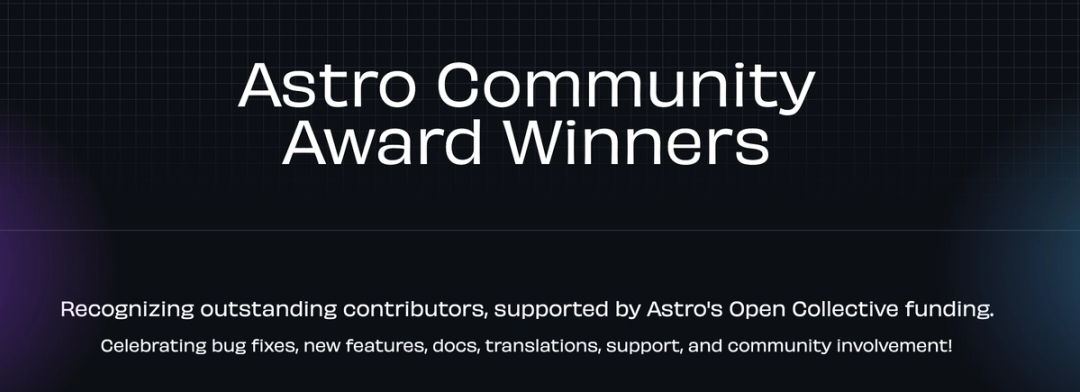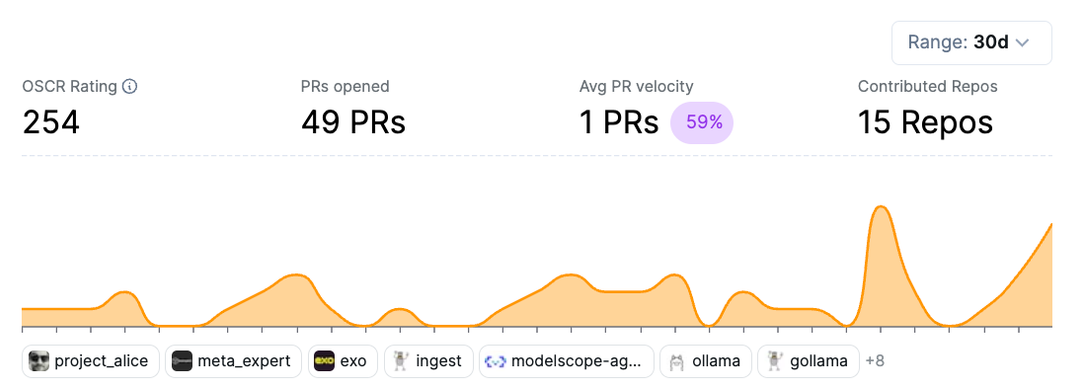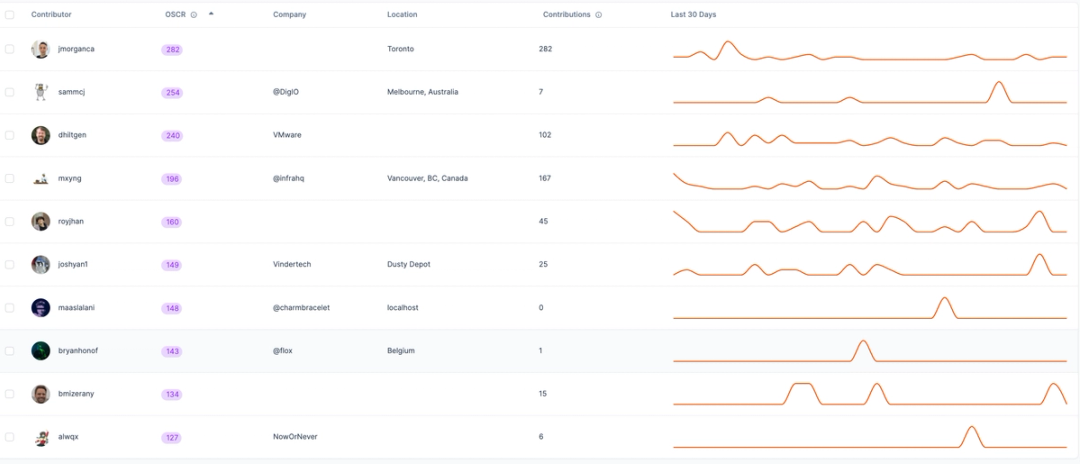
#OSCR
Unseen Impact: A Holistic View of Open Source Contributions
BekahHW
7 mins read

I've always appreciated that when you go to Astro's Community Page, they show you a list of Astro Community Award Winners.

They point out that it's not just code, but also documentation, community support, and more.
One of the most powerful actions we can take is recognizing the contributions of others. 58% of maintainers have either quit or considered quitting their projects, according to a 2023 Tidelift survey.
But how can we recognize the contributions of others if we don't know what they are doing? It's not just the loudest projects in the room that get the most recognition; it's often the loudest and most visible contributors and maintainers that are getting noticed. We celebrate the most starred repos, the viral projects, and the contributors who are speaking in public about their work. But what about the contributors working quietly behind the scenes? How can we recognize contributions when they're not always visible? One way to do this is to look at the broader impact of contributors across the open source ecosystem by using the Open Source Contribution Rating (OSCR) score.
The OSCR score is a metric that measures the impact of a contributor's work across all the open source projects they contribute to over a period of 90 days. It takes into account not just the quantity of contributions but also their quality, ability to create and maintain impactful conversations, and their impact on the open source ecosystem. By looking at contributors through the lens of OSCR scores, we can gain a more nuanced understanding of their value and impact.
This invisibility problem has real consequences. Consider this:
1. Recognition Goes Beyond Code
That contributor who always clarifies issues? They're improving your project's accessibility. The person who consistently reviews PRs? They're maintaining code quality. We don't want valuable contributors to go unnoticed and unrewarded.
2. Context is King
Understanding the context of contributions can reveal surprising insights. Maybe that sporadic contributor is actually a key maintainer of a critical dependency. Or perhaps that newcomer with small but frequent commits is a rising star in a niche technology your project uses.
3. Sponsorship: Supporting the Ecosystem
Many of us rely on open source projects we don't directly contribute to. Identifying key contributors in these projects for sponsorship isn't just generous—it's an investment in the health of our entire ecosystem.
What if we could peel back the layers and see more of the full picture of contribution in our projects? If you could understand who's pushing code, who's sparking important conversations, who's improving documentation, and who's maintaining the heartbeat of the community? This isn't just about satisfying curiosity. It's about understanding the true pillars of our projects. It's about recognizing that the person consistently clarifying issues might be just as important for project health as the top code contributor. It's about acknowledging that the community member who always leaves thoughtful, constructive reviews is helping maintain code quality in ways that don't show up in commit logs.
Case Study: ollama/ollama
Let's take a closer look at Ollama, an open-source project for running large language models locally. When we look at Ollama's contributor list, we see a variety of contributors, including - but not limited to - developers who are working fulltime on the project.
The high impact contributors aren't just contributing to Ollama. They're also contributing to other projects. This is a key insight that can help us understand the broader impact of these contributors on the open source ecosystem.
For example, sammcj has a high OSCR score of 254, indicating that they're making significant contributions not just to Ollama, but to other projects as well. When we look at his profile, we see a variety of contributions, including driving conversations, writing issues, and creating PRs in different projects.

This kind of insight can help us identify key contributors who are shaping the open source landscape beyond their immediate projects.
Open Source Excellence: The Vercel/Next.js Example
To truly appreciate the significance of these OSCR scores, let's look at a standout example: Next.js.
Next.js showcases the power of cultivating high-impact contributors, and they're contributor base is nothing short of remarkable: their top 16 contributors all fall within the top 5% of OSCR scores across the entire open source ecosystem. But what does this really mean?
- Concentration of Talent: Next.js has managed to attract and retain some of the most impactful contributors in open source. These aren't just good developers; they're shaping the future of web development across multiple projects and communities.
- Culture of Open Source: This concentration of high-scoring contributors suggests that Next.js has cultivated a culture that not only values open source contributions but actively encourages impactful engagement with the broader community.
- Ripple Effects: The influence of these top contributors likely extends beyond Vercel's projects. Their high OSCR scores indicate they're making waves across the open source ecosystem, contributing to a wide range of projects and discussions.
- Attracting Talent: Such a concentration of top contributors can create a snowball effect, attracting other talented developers who want to work alongside the best in the field.
- Industry Leadership: This data point cements Vercel's position as a leader not just in their product offerings, but in their approach to open source collaboration and community building.
For other companies and projects, Next.js's contributor profile serves as both an inspiration and a challenge. It raises important questions:
- How can we create an environment that encourages this level of open source engagement?
- What can we learn from Next.js's approach to attracting and retaining high-impact contributors?
- How might this level of open source engagement translate to product quality, innovation, and community trust?
By understanding and valuing these high-impact contributors, measured not just in lines of code but in their broader influence across open source, we gain a new perspective on what it means to be a leader in open source.
The Ecosystem Perspective: Why Your Contributors' Outside Work Matters
When we talk about open source contributors, it's easy to focus solely on their work within our own projects. But this view misses a key point: the open source world is an interconnected ecosystem, and understanding your contributors' impact across this ecosystem can be just as valuable as tracking their contributions to your project.
Why should we care about our contributors' work beyond our repository?
- Cross-Pollination of Ideas: Contributors active in multiple projects can bring fresh perspectives and interesting solutions. They've seen problems solved in different ways and can apply that knowledge to your project. By recognizing their broader contributions, you're tapping into a wealth of diverse experiences.
- Community Connections: High-impact contributors often have larger networks in the open source world. Their connections can lead to valuable collaborations, increased project visibility, and a broader pool of potential contributors. A contributor might play a minor role in your project but be a major influencer in a related technology. Understanding their broader impact helps you leverage their expertise more effectively.
- Predicting Long-Term Commitment: Contributors who are deeply engaged in the open source ecosystem are often more likely to remain committed to open source work long-term, potentially leading to more sustained contributions to your project.
- Reputation by Association: Having well-respected open source contributors associated with your project can enhance its credibility and attract more attention from the wider community.
- ** Ecosystem Health**: By valuing and recognizing broader contributions, you're encouraging a healthier open source ecosystem overall, which ultimately benefits all projects, including yours. Understanding the diverse contributions of your community members opens up opportunities for mutual learning and mentorship within your project.
Consider the case of a contributor who infrequently commits to your project but has a high OSCR score. This person might be a key maintainer of a critical dependency, an influential voice in relevant technical discussions, or a mentor to new contributors. Their seemingly small contributions to your project might be a small part of the story of their open source impact.
By adopting this ecosystem perspective, we shift from a transactional view of contributions to a more holistic understanding of value. It's not just about what a contributor does for your project, but how their involvement in your project fits into their broader open source story – and how that story enriches your project's journey.
This approach allows for a more interconnected, collaborative open source community. It encourages projects to see themselves not as isolated entities, but as part of a larger, interdependent ecosystem.
Here's my challenge to you: Take a fresh look at your project's contributors. Who are the unsung heroes? Whose contributions, beyond code, are making a real difference? And in the projects you depend on, who are the key contributors you might consider supporting?
Want to explore more projects and contributors? Check out these other projects on OpenSauced:
Or explore the top 5% of all OSCRs across the entire open source ecosystem.

BekahHW
Bekah graduated from a coding bootcamp in May of 2019 and since then has spent time as a frontend developer, started the Virtual Coffee tech community, spent time in DevRel and has continued to mom her four kids. She currently co-hosts the Compressed.fm and Virtual Coffee podcasts, lifts heavy things in her free time, & works as the Developer Experience Lead at OpenSauced.
Recent Posts

bdougie
2 mins read
OpenSauced joins Linux Foundation, making AI-powered open source analytics freely available while expanding beyond GitHub to serve the broader open so...

#kubernetes
John McBride
5 mins read
How the OpenSauced engineering team made a near-zero downtime migration to Microsoft Azure



